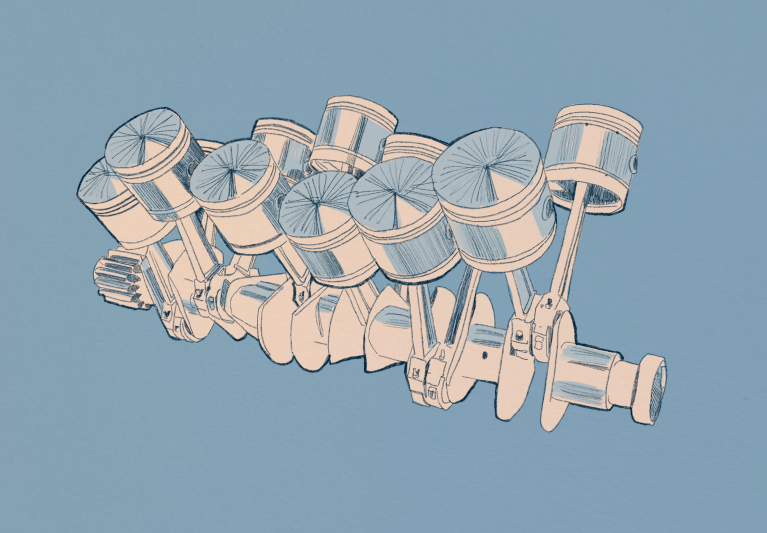Professors can feel inadequate, too. Let’s draw upon an example from one day back in early March, when my economics professor paced across the lecture hall to no end, tangentially detailing the drama of a recent conference at the Stanford Institute for Economic Policy Research. In short, he named the supply shortage of semiconductors as a contributor to the sky-high prices that are taking the automotive industry by storm. He did not understand, however, why computer chips were so essential to the manufacturing process, and given that he holds undergraduate and graduate degrees in electrical engineering, he told us that he was afraid to ask his colleagues at the conference. Such an inquiry would expose the humiliating reality of his imperfect knowledge of the subject matter — supposedly.
This outward confession from a leading academic that he is a human being, just like the rest of us — with fears and instances of self-doubt — provided, rather notably, a quaint sensation of relief.
Then, a few PowerPoint slides later, he told us that we would now take five minutes to stretch, drink water or use the restroom.
Several of my classmates took this “break” as an opportunity to line up before the dais and ask more questions to the professor. Since I was already seated reasonably close to him, I figured it wouldn’t hurt to listen in on what my professor was saying in response to the students. Soon enough, though, he had answered their questions on exchange rates and globalization with apparent ease and was now preparing to resume the lecture. Except, not before he noticed that I was still staring at him.
“You have a quick question?” he said.
“Well, I don’t really have a question about econ right now, but I think a lot of cars need some kind of a microprocessor for the engine control unit,” I said.
“Oh, great!” he said, grabbing his laser pointer from the podium. “Send me an email about it.”
For the rest of the lecture, I kept thinking, “Maybe I shouldn’t talk. Then I wouldn’t have to write emails about engine control units.”
At the end of that week, I started to compose the dreaded message to my professor. Once it was drafted, I read it over and considered my writing a swirling billow of unrelated wonderments at best. Something about valve movement in one sentence, a tangent about oxygen levels in the next. The incoherence was pitiful. Toward the end, I concluded, “I guess there are a lot of moving parts in cars, and you wouldn’t want those parts to move in the wrong way,” and pressed “Send” anyway.
Just days later, as fate would have it, Aston Martin unveiled its new V12 Vantage, a car whose 690-horsepower, longitudinal engine had better come with a control unit. In the live stream, I learned that it can produce 420 pound-feet of torque at 6,500 revolutions per minute and reaches 60 miles per hour in 3.4 seconds. Oh, and did I mention that it has a six-speed manual transmission? The Vantage is a driver’s car through and through. Never mind the price.
“This is not the product of shyness, but one of intensity,” according to Tobias Moers, a former Aston Martin chief executive. “It is a car for those who stand up and announce themselves, a car for drivers who seek intoxicating performance.”
Alas, yet, intoxication as we know it is not eternal. With the steady political march toward lowered emissions of greenhouse gasses, the phasing out of traditional, gasoline-powered engines is all but inevitable. As Moers continued to tout the car as a “spectacular finale for an iconic bloodline,” twinges of bittersweet memories cascaded down the comments section. I knew that another 12-cylinder Aston Martin was not in the pipeline — and so did Moers.
“This is the last of the breed, the final time we’ll put our biggest engine into our most agile sports car,” he said.
For most, I would imagine, this news is hardly tear-jerking. But to me, it’s the beginning of the end of an automotive era that’s interwoven with my childhood. It’s the discontinuation of not only a feat of engineering, but a feat of artistry that symbolizes the unencumbered joy I once found in naturally aspirated internal combustion, Sunday cruising and the deep redolence of leather.
Internal combustion is a paragon of controlled chaos. I knew this factoid in first grade, when my older sister and I presented on the phenomenon at our lower school’s science fair. Our trifold board was plastered with goofy screenshots of race cars from “Toontown” and abstruse chemical diagrams that, in all likelihood, we obtained from a brisk Google Search. Pages upon pages of animations abounded the Internet as well — typically demonstrating the compression-ignited systems in diesels. Something about all that hot air and fuel repeatedly getting squashed by pistons seemed like a disaster waiting to happen. Cool! One of these days, one of those explosions is going to be a little too strong, no? But maybe an element of perceived precarity made it invigorating to study.
At that time, a few months into 2009, the first-generation Tesla Roadster had already hit the market. In the years since, the heavy-hitting Lamborghini Aventador has seen its heyday and is signing off as the Ultimae; BMW has announced a model based on its M760i xDrive that will be called the Final V12.
Indeed, many others are already in the rear-view mirror, including the Rolls-Royce Phantom, the McLaren F1 and the Jaguar E-Type. These gas-guzzling, atmosphere-polluting beauties will pass on the torch now, ringing in a new era.
Conversely, not all recent developments in the advent of this era came with a warning. Take last summer for instance, when a 13-year-old electric car manufacturer from Croatia called Rimac Automobili merged with Bugatti. The 123-year-old French brand is known for its breakneck supercars whose quad-turbocharged engines take a single minute to pump in the amount of air a human breathes in five days and can deplete a full tank of gasoline faster than you can read the Wikipedia entry on carbon monoxide.
“It cannot be,” you say. But it is. Heck, even Hummers are electric now, and one of them was parked by Florence Moore Hall last month.

Call it obscene — go right ahead. But in any case, may we agree that this vehicle is … different.
Different. Maybe that’s what I’ll miss — the variation, the enrichment of the intermingling of so many types of cars. No man drives down the same road twice, so to speak. This transient stage between rumbling, strictly internal combustion and whirring, strictly electric locomotion will likewise come and go, to be replaced by another unique landscape, if only a forbearing one.
Humility is a road that ought never to go out of style. And simultaneously, there’s something unshakable about the three silent words that overlay the final frame of the Vantage’s unveiling. As it screams down an open street with all its might, streaks of red trail the taillights. Then, the conclusion comes into resolution: “NEVER LEAVE QUIETLY.” It’s a chilling moment, almost as if a keen ear were to listen closely, the ghost of Dylan Thomas could be heard.
